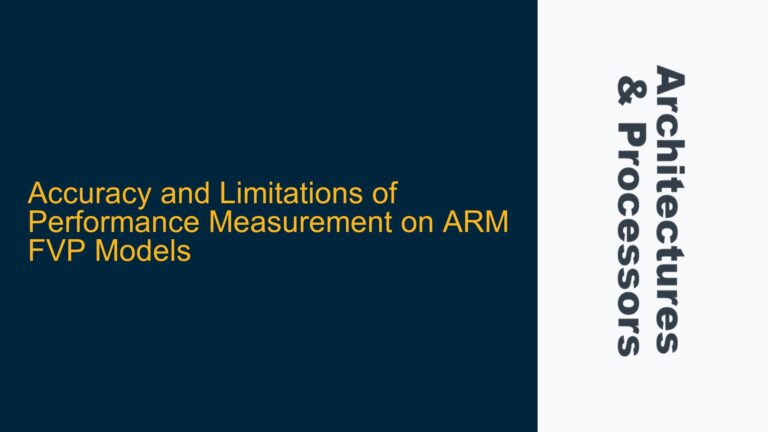ARM Neon MMLA Instructions and Their Data Layout Challenges
The ARM Neon Matrix Multiply-Accumulate (MMLA) instructions, such as SMMLA, are powerful tools for accelerating matrix operations in embedded systems. These instructions are designed to perform signed 8-bit integer matrix multiplications, specifically multiplying a 2×8 matrix by an 8×2 matrix to produce a 2×2 matrix of 32-bit integer results. While these instructions offer significant performance benefits, their efficiency is heavily dependent on the data layout and loading strategies employed. The challenge lies in ensuring that the input matrices are correctly aligned and loaded into the Neon registers to maximize throughput and minimize unnecessary memory accesses.
The primary issue arises from the mismatch between the natural data layout of matrices in memory (row-major or column-major) and the specific data layout required by the MMLA instructions. For instance, a row-major matrix stores elements row by row, while a column-major matrix stores elements column by column. However, the MMLA instructions require the input matrices to be loaded in a specific interleaved format that matches their 2×8 and 8×2 operand shapes. This mismatch often leads to inefficient loading and storing of data, as demonstrated in the example code provided, where multiple vld1_u8 and vcombine_u8 operations are used to load and combine data into the required format.
The inefficiency in the example code stems from the need to manually interleave and combine data from multiple rows and columns into the correct format for the MMLA instructions. This process not only increases the number of memory accesses but also consumes valuable CPU cycles that could otherwise be used for computation. Additionally, the example code does not fully utilize the available Neon registers, leading to suboptimal performance. To address these challenges, it is essential to understand the underlying causes of inefficiency and implement strategies to optimize data loading and layout.
Memory Access Patterns and Register Utilization in MMLA Workloads
The inefficiency in the example code can be attributed to several factors related to memory access patterns and register utilization. First, the code loads data from multiple rows and columns using separate vld1_u8 instructions, which results in multiple memory accesses for each iteration of the loop. This approach is inefficient because it does not take advantage of the Neon architecture’s ability to load multiple elements in a single instruction. Additionally, the use of vcombine_u8 to combine the loaded data into the required format further increases the computational overhead.
Another issue is the underutilization of Neon registers. The example code only processes a small portion of the input matrices in each iteration, leaving many registers unused. This underutilization limits the potential performance gains that could be achieved by processing larger tiles of data in parallel. Furthermore, the code does not consider the alignment of data in memory, which can significantly impact the performance of memory accesses. Misaligned data accesses can lead to additional memory cycles and reduced throughput.
The choice of data layout (row-major or column-major) also plays a critical role in the efficiency of MMLA workloads. In the example code, the input matrices are stored in row-major and column-major formats, which do not directly align with the 2×8 and 8×2 operand shapes required by the MMLA instructions. This misalignment necessitates additional data manipulation to convert the input matrices into the required format, further increasing the computational overhead.
To address these issues, it is essential to optimize the memory access patterns and register utilization in MMLA workloads. This can be achieved by loading larger tiles of data in each iteration, ensuring that the data is properly aligned in memory, and minimizing the number of memory accesses and data manipulation operations. Additionally, the choice of data layout should be carefully considered to minimize the need for data conversion and maximize the efficiency of the MMLA instructions.
Implementing Efficient Data Loading and Layout Strategies for MMLA
To optimize the performance of ARM Neon MMLA instructions, it is crucial to implement efficient data loading and layout strategies. The following steps outline a comprehensive approach to addressing the challenges discussed above:
Step 1: Optimize Memory Access Patterns
The first step in optimizing MMLA workloads is to minimize the number of memory accesses by loading larger tiles of data in each iteration. Instead of loading individual rows and columns using multiple vld1_u8 instructions, it is more efficient to load multiple rows and columns in a single instruction using vld1q_u8 or similar vector load instructions. This approach reduces the number of memory accesses and allows for better utilization of the Neon registers.
For example, consider a scenario where the input matrices are stored in row-major format. Instead of loading each row separately, it is possible to load two rows at a time using a single vld1q_u8 instruction. This approach not only reduces the number of memory accesses but also ensures that the data is loaded in a format that is more compatible with the MMLA instructions. Similarly, for column-major matrices, it is possible to load multiple columns at a time using vector load instructions.
Step 2: Ensure Proper Data Alignment
Proper data alignment is critical for maximizing the performance of memory accesses in MMLA workloads. Misaligned data accesses can lead to additional memory cycles and reduced throughput. To ensure proper alignment, it is recommended to align the input matrices on 16-byte boundaries. This alignment ensures that the data can be loaded into the Neon registers using a single memory access, minimizing the overhead associated with misaligned accesses.
In addition to aligning the input matrices, it is also important to align the output matrices on 16-byte boundaries. This alignment ensures that the results of the MMLA instructions can be stored efficiently without incurring additional memory cycles. Proper alignment of both input and output matrices is essential for achieving optimal performance in MMLA workloads.
Step 3: Minimize Data Manipulation Operations
To further optimize MMLA workloads, it is important to minimize the number of data manipulation operations required to convert the input matrices into the required format. This can be achieved by carefully choosing the data layout of the input matrices to match the operand shapes required by the MMLA instructions. For example, if the MMLA instructions require a 2×8 matrix, it is more efficient to store the input matrix in a format that closely matches this shape, rather than converting from a row-major or column-major format.
One approach to minimizing data manipulation operations is to use a custom data layout that interleaves the rows and columns of the input matrices in a way that matches the operand shapes required by the MMLA instructions. This approach eliminates the need for additional data manipulation operations and allows the MMLA instructions to operate directly on the input data. While this approach may require additional effort to implement, it can significantly improve the performance of MMLA workloads.
Step 4: Maximize Register Utilization
Finally, it is important to maximize the utilization of Neon registers in MMLA workloads. This can be achieved by processing larger tiles of data in each iteration, rather than processing small portions of the input matrices. By processing larger tiles, it is possible to fully utilize the available Neon registers and achieve higher throughput.
For example, instead of processing a single 2×8 matrix in each iteration, it is possible to process multiple 2×8 matrices in parallel using the available Neon registers. This approach not only increases the utilization of the registers but also allows for more efficient use of the MMLA instructions. Additionally, processing larger tiles of data reduces the number of iterations required to complete the computation, further improving performance.
Step 5: Implement Data Synchronization Barriers
In some cases, it may be necessary to implement data synchronization barriers to ensure that the results of the MMLA instructions are correctly synchronized with the rest of the system. This is particularly important in multi-core systems where multiple threads may be accessing the same data. Data synchronization barriers ensure that the results of the MMLA instructions are visible to all threads and that the system operates correctly.
To implement data synchronization barriers, it is recommended to use the dsb (Data Synchronization Barrier) instruction provided by the ARM architecture. This instruction ensures that all memory accesses are completed before proceeding to the next instruction, preventing data races and ensuring correct operation of the system.
Step 6: Profile and Optimize
The final step in optimizing MMLA workloads is to profile the code and identify any remaining performance bottlenecks. This can be achieved using profiling tools such as ARM Streamline or similar performance analysis tools. By profiling the code, it is possible to identify any remaining inefficiencies and implement further optimizations to improve performance.
For example, profiling may reveal that certain memory accesses are still causing performance bottlenecks, or that certain data manipulation operations are consuming more CPU cycles than expected. By identifying these bottlenecks, it is possible to implement additional optimizations to further improve the performance of the MMLA workloads.
Conclusion
Optimizing data layout and loading strategies for ARM Neon MMLA instructions is essential for achieving high performance in matrix multiplication workloads. By optimizing memory access patterns, ensuring proper data alignment, minimizing data manipulation operations, maximizing register utilization, implementing data synchronization barriers, and profiling the code, it is possible to significantly improve the efficiency of MMLA workloads. These strategies not only improve the performance of the MMLA instructions but also ensure that the system operates correctly and efficiently.






